|
Background
to the
Liechtenstein Federal Contingent
Following the Napoleonic Wars
the German Federal Parliament in
Frankfurt (of which
Liechtenstein was a member)
called upon every state to
provide an armed force in case
of war. The size of the armed
force was set at 1.5% of the
population, so the tiny
Principality of Liechtenstein's
contingent was 82 men in 1862.
As a
very small mountainous country
sandwiched between Switzerland
and Austria, it was unique among
the many small German states in
not having a land border with
any member of the German
Confederation other than
Austria.
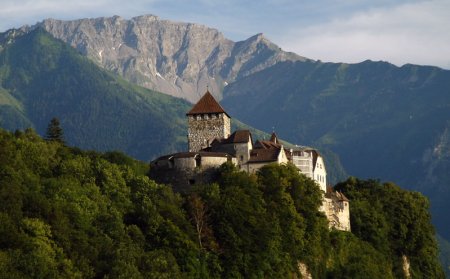
Schloss Vaduz. the home of the
Princes of Liechtenstein
Photo from
Wikipedia by Michael
Gredenberg
The
Liechtenstein military
contingent was raised in 1836,
when they reached agreements
with the similarly small states
of
Hohenzollern-Hechingen and
Hohenzollern-Sigmaringen about
the formation of a joint
battalion.
The
Liechtenstein contingent was
organised as one light infantry Sharpshooter
Platoon or Scharfschützenzug,
of the joint
Hohenzollern
battalion. In 1866, it
consisted of an officer (Oberleutnant),
a staff sergeant (Feldwebel),
two sergeants (Sergeanten),
four corporals (Korporale),
three Lance Corporals (Vizekorporale)
and 71 soldiers.
The
army was unpopular at home in
Liechtenstein with protests in
1848 demanding that it be
disbanded. This was mainly
because of the cost on tax
payers for this ineffective
force but also the fact that
their soldiers were commanded by
foreigners. The commanding
officers had since 1836, been
seconded from the Austrian or
Bavarian armies.
The
contingent took a part in
suppressing the Baden
Revolutionaries in 1849 at the
Battle of Oos but suffered no
casualties. The veterans of the
campaign were later awarded a
campaign medal.
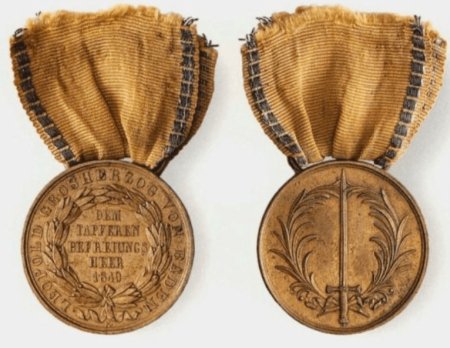
Liechtenstein Medal for Veterans
of the Baden Campaign, 1849
Liechtensteinisches LandesMuseum
That
same year, Prussia annexed
Hohenzollern-Hechingen and
Hohenzollern-Sigmaringen and
Lichtenstein's short alliance
with those other two tiny states
ended. This left Liechtenstein's
tiny force without either a
geographical or command
connection to the other German
armies.
In
1859, Oberleutnant Peter
Rheinberger a native of
Liechtenstein who had previously
passed his Prussian army officer
training in Sigmaringen, was
appointed as commander of the
contingent. He was the first and
only Liechtensteiner to command
their army and his uniform is
displayed at the Liechtenstein
National Museum. He soon set about
reforming the small force, along
with his trusty Feldwebel Andreas Walch.
They both remained in their
positions until the army's later
disbandment.
The
Austro-Prussian War of 1866
As the German
Confederation was drawn into the
Austro-Prussian War of 1866 and
the smaller German states chose
their sides, Liechtenstein under
Prince (Fürst)
Johann II predictably sided with
her larger neighbour, Austria
though chose not to fight fellow
Germans but be deployed to the
Italian Front instead.
Leaving two soldiers behind to
guard the princely palace, the
80 strong unit set off to occupy
the Stilfserjoch (now
known as the Stelvio pass, and
famous for its road with 48
hairpin bends) in
South Tyrol near the Swiss
border.
After a few weeks there from
July to September 1866 and
seeing no action, they returned
to Liechtenstein along with
their Austrian Kaiserjäger
liaison officer, Leutnant
Radinger.
Having gone to war with 80 men
and returned with 81, this is
often repeated in folklore as
the only time an army has gone
to war, suffered no casualties
and come back with more men.
Despite the nice story, he was
their liaison officer after all
and simply saw them home through
his native Austrian territory.
Soon afterwards he returned to
Vienna.
Following the war, the German
Confederation and the Frankfurt
Parliament was dissolved and so
the Liechtenstein contingent was
no longer demanded. It was
disbanded by Prince Johann II on
12 February 1868 being replaced
by a civil gendarmerie. They
have not raised an army since.
And with the dissolution of the
Confederation, Liechtenstein's
ties to the other German states
were cut forever.
They
did not take part in the
Franco-Prussian War nor the
German Unification of 1871,
remaining isolated as the last
of the many former tiny
independent states of the German
Confederation. The Principality
of Liechtenstein remained
neutral in both World Wars and
has not raised an army since.
Uniforms
Liechtenstein army uniforms were
in black piped in red. National
cockades were white with a red
centre.
1836 Uniforms
The original
uniforms consisted of a black
double breasted coatee, piped in
red with collar, cuffs, shoulder
straps and coatee tail
turn-backs in red. Buttons were
in white metal. Officers wore
collar and cuff Litzen and
shoulder epaulettes. NCOs also
had Litzen and were
distinguished in rank by
diagonal bands of lace on the
left forearm. Trousers were
matching black piped in red down
the outside edge. A tall black
shako was worn with white metal
insignia on the front, white
metal chin-scales and topped
with a national coloured
cockade.
Updated Tunics
At some point
in the 1840s or 50s the tunic
was re-designed following
Austrian fashion, though still
in black with red piping. The
front remained double breasted
with two rows of plain buttons
and piped down the right hand
side. The cuffs were now plain
turn-back with one piping band
and two cuff buttons. The
standing collar was black with
red piping all around. The tunic
was also piped around the lower
edge.
Rank was shown in the Austrian
style with stars on the collar.
The officer wore three stars, so
presumably NCO ranks wore one
and two.
M1845 Shako
In 1845 the
shako was scaled down in height
from the tall shako of 1836. It
bore an eight pointed star
bearing the
Liechtenstein crowned shield and
a national cockade at the top.
On parade a black horsehair
plume was worn.
M1859 Helmet
In 1859 a
Bavarian style crested helmet,
the Raupenhelm was
introduced. It
was identical to the Bavarian
design, even having the Bavarian
Lion chin-scale attachments. As
a light infantry unit, they wear
the green plume of the Bavarian
Jäger too. The only differences
are the Liechtenstein star and
crowned shield in yellow metal
and national cockade on the left
hand side.
Kepi
An
Austrian-style Kepi with a
national cockade and short loop
of lace around a lower button
with a black leather peak and
chin-strap, was also worn. From
the only known period
photographs, this is mostly
likely what was worn by the
contingent on the 1866 Campaign.
Possible timeline of Uniform
Changes
I have not been able to find the
uniform regulations of the
Liechtenstein army. Based on the
very few illustrations and
photographs that I have seen
(most which are on this page), I
would guess that there were
three main changes of uniform.
If any reader has more reliable
information
please
contact me here.
1836- Coatee tunic, tall shako,
white metal fittings
1845- Austrian style tunic,
shorter shako, white metal
fittings
1859- Austrian style tunic,
Bavarian style helmet, yellow
metal fittings.
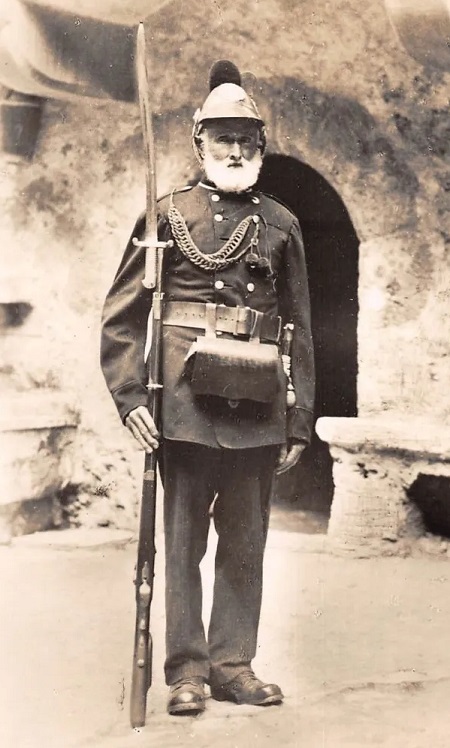
Andreas Kieber, the last
surviving member of the
Liechtenstein Army and a veteran
of the Austro Prussian War,
c1935
He still wears his old uniform
with a marksmanship lanyard and
Raupenhelm with rifle and
bayonet.
Photo
from
Last Stand on Zombie Island
Article
Sources
and Links
Liechtenstein National Museum -
Liechtensteinisches LandesMuseum
Excellent Liechtenstein Military
History Article in German
by
Fabian Frommelt
&, Rupert Quaderer
Der
1866er Feldzug des fürstlich
liechtensteinischen
Bundeskontingentes
War History Online Article
Last Stand on Zombie Island
Article
Thanks very much to CT for his
excellent research starting this
page.
|
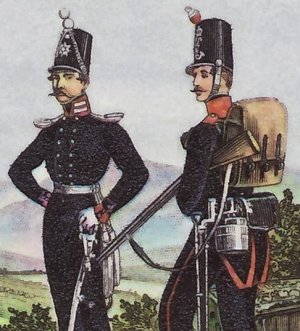
Liechtenstein
Officer and Solider, 1836
Unknown Artist at
Wikipedia

Private Bernhard Schädler, 1866
He wears the later style
black tunic piped in red and the
and kepi cap worn on campaign.
Liechtensteinisches LandesMuseum
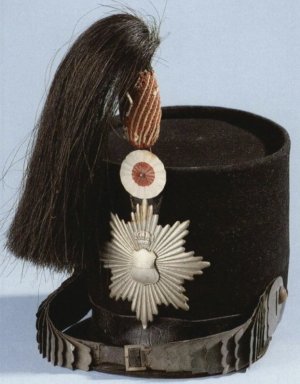
M1845 Shako
Note the white metal eight
pointed star bearing the
Liechtenstein crowned shield in
white metal, the national
cockade and parade plume.
Liechtensteinisches LandesMuseum
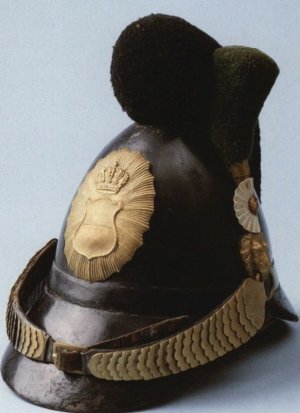
M1859
Raupenhelm
Note that it is identical to the Bavarian design, even
having the Bavarian Lion chin-scale attachments. As a
light infantry unit, they wear the green plume of the
Bavarian Jäger too. The only differences are the
Liechtenstein star and crowned shield in yellow metal
and national cockade on the left hand side.
Liechtensteinisches
LandesMuseum
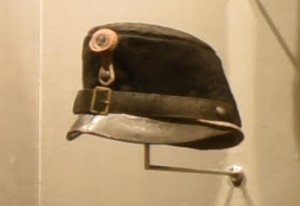
Kepi c1866 with national cockade
Liechtensteinisches
LandesMuseum
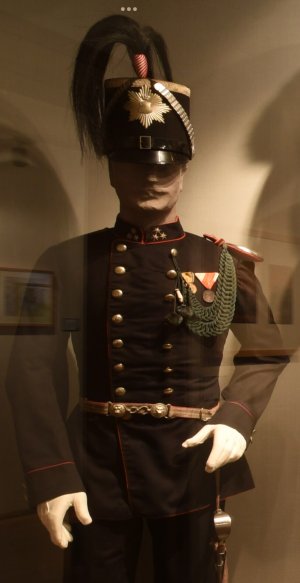
Officers Uniform c1868
This is the only known surviving uniform of the
Liechtenstein Army and belonged to their commander,
Oberleutnant Peter Rheinberger. The shako has its parade
plume and star bearing the Liechtenstein crowned shield,
the uniform has the black double breasted tunic with red
piping. Note the Austrian style rank stars on the collar
as well as the two medals, the Liechtenstein Medal for
Veterans of the Baden Campaign of 1849 and the Austrian
Medal for Veterans of the Italian Campaign of 1866 and
dark green marksmanship lanyard.
Liechtensteinisches
LandesMuseum
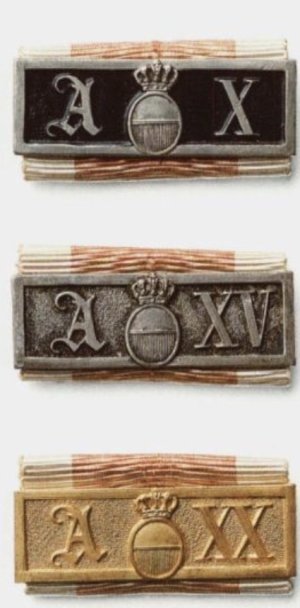
Long Service Awards
From top to bottom, third class in black for 10 years
service, second class in silver for 15 years and first
class in gold for 20 years service. These awards all
bear the monogram of Fürst Alois II, which was replaced
from 1858 with a J for Johann II.
Liechtensteinisches
LandesMuseum
|